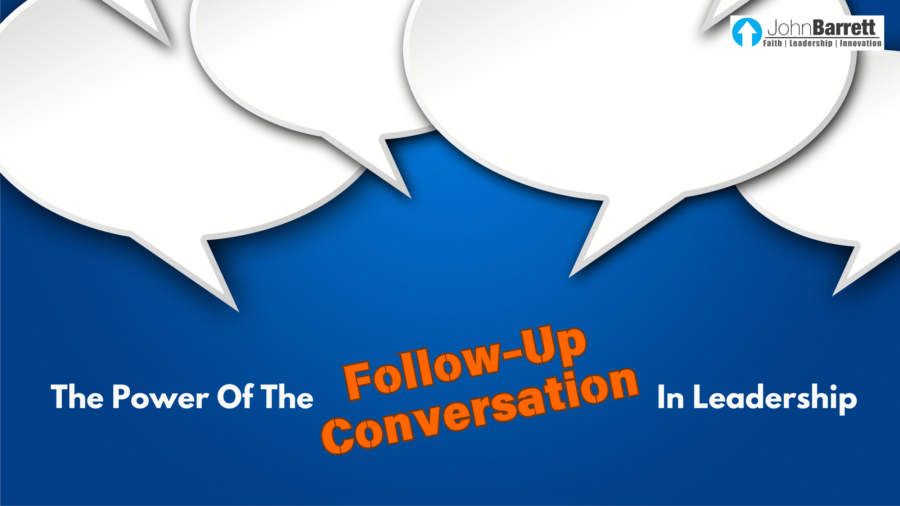The Power of the Follow-Up Conversation in Leadership
As leaders, we often find ourselves navigating challenging conversations. Whether addressing underperformance, resolving conflict, or providing critical feedback, these moments test our emotional intelligence and communication skills. Yet, many leaders walk away from such conversations feeling like they missed the mark. “I should have said this” or “I could have explained that better” often echo in our minds after the fact. If you’ve ever felt this way, rest assured: the opportunity isn’t lost. The follow-up conversation is a powerful tool every leader should have in their leadership toolbox.
Recognizing the Opportunity in Reflection
In the moment, it’s completely natural to feel caught off guard during hard conversations. Emotions can run high, and even the most seasoned leaders may not articulate everything they intended. Reflection, however, allows us to process the interaction more thoughtfully. It’s during this reflection that clarity emerges, helping us recognize what we wish we had communicated.
Great leaders don’t see this as a missed opportunity but as a starting point. A follow-up conversation lets you reengage with intentionality, allowing you to address unresolved issues or offer a clearer perspective. This approach not only continues the conversation but also deepens trust and respect between you and your team members.
Why Follow-Up Conversations Matter
- Demonstrates Care and Thoughtfulness – When you return to a prior discussion with deeper insights, it sends a clear message: “I’ve been thinking about what we discussed because it’s important to me.” This shows your team members that you value their input and the relationship enough to revisit the conversation.
- Clarifies Misunderstandings – Miscommunication often arises during tough conversations, leaving room for ambiguity or misinterpretation. A follow-up provides an opportunity to clear up misunderstandings, ensuring everyone walks away with aligned expectations and understanding.
- Builds Emotional Safety – Revisiting a conversation in a thoughtful way can create a safe space for team members to share additional perspectives. This helps foster an environment where feedback flows freely, which is critical for building trust.
How to Execute a Follow-Up Conversation
Effective follow-up conversations require preparation and a constructive mindset. Here are actionable steps to help guide you:
1. Acknowledge The Initial Conversation
Start by referencing the original discussion. For example:
- “I’ve been reflecting on our conversation last week, and I wanted to follow up because I think there are some additional points worth discussing.”
This sets the stage for a meaningful conversation and shows that you’ve put thought into the follow-up.
2. Frame The Follow-Up Positively
Avoid making the other person feel like the first conversation was a failure. Instead, position this as an opportunity to build on what’s already been discussed:
- “I’ve had some additional thoughts that I believe will help us move forward even more effectively.”
A positive framing ensures the other person remains open to engaging further while feeling you are for them, not against them.
3. Provide Context And Clarity
Address the points you’ve reflected on with specificity. Whether it’s additional guidance, context, or feedback, ensure you articulate it clearly:
- “I realized I could have provided more context about why this project’s timeline is so critical. It’s because it impacts our client’s deadlines and ultimately builds trust in our partnership.”
Clarity reduces ambiguity and helps people understand the bigger picture.
4. Invite Feedback And Collaboration
Encourage dialogue by asking for their perspective. This keeps the conversation two-sided and collaborative:
- “What are your thoughts on this? Do you think there’s anything else we need to address to make this work better?”
5. End On A Constructive Note
Summarize key takeaways and reinforce your commitment to their growth and the success of the team:
- “I appreciate your willingness to revisit this. Let’s stay aligned as we move forward, and don’t hesitate to bring up anything else on your mind.”
The Long-Term Benefits
Incorporating follow-up conversations into your leadership style does more than resolve issues—it builds a culture of trust, accountability, and continuous growth. Your team will learn that you are not only approachable but also deeply invested in their success. This approach leads to better engagement, stronger relationships, and ultimately, much better results.
Leadership isn’t about getting everything perfect in the moment; it’s about modeling consistency, growth, and care over time. The follow-up conversation exemplifies these traits by showing that you’re willing to revisit and refine. So the next time you walk away from a tough conversation feeling like you could have done better, remember: the door to communication is still open.
Great leaders don’t just rely on first impressions—they ensure lasting ones. Never underestimate the power of following up. It might just transform a difficult moment into a breakthrough one later.









